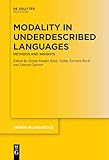Modality in Underdescribed Languages : Methods and Insights / ed. by Jozina Vander Klok, Núbia Ferreira Rech, Simone Guesser.
Material type: TextSeries: Trends in Linguistics. Studies and Monographs [TiLSM] ; 357Publisher: Berlin ; Boston : De Gruyter Mouton, [2022]Copyright date: ©2022Description: 1 online resource (VI, 423 p.)Content type:
TextSeries: Trends in Linguistics. Studies and Monographs [TiLSM] ; 357Publisher: Berlin ; Boston : De Gruyter Mouton, [2022]Copyright date: ©2022Description: 1 online resource (VI, 423 p.)Content type: - 9783110721287
- 9783110721560
- 9783110721478
- P299.M6 M644 2023
- online - DeGruyter
- Issued also in print.
| Item type | Current library | Call number | URL | Status | Notes | Barcode | |
|---|---|---|---|---|---|---|---|
 eBook
eBook
|
Biblioteca "Angelicum" Pont. Univ. S.Tommaso d'Aquino Nuvola online | online - DeGruyter (Browse shelf(Opens below)) | Online access | Not for loan (Accesso limitato) | Accesso per gli utenti autorizzati / Access for authorized users | (dgr)9783110721478 |
Frontmatter -- Contents -- Introduction to Modality in underdescribed languages: Methods and insights -- Part I: Contributions of different methods for studying modality -- 1 Fieldwork techniques in semantics -- 2 Studying modality through targeted construction storyboards -- 3 Discourse contexts targeting modality in fieldwork: A revised modal questionnaire -- 4 Using corpora to investigate modal-temporal interactions -- 5 Adapting acquisition methodologies to study modality in underdescribed languages -- Part II: Lessons from case studies on underdescribed languages -- 6 On applying semantic fieldwork elicitation techniques to describe modality in Ye’kwana -- 7 Modality in elicited data and spontaneous texts: A case study of Atayal -- 8 Lessons from the field: Irrealis mood in Lung’Ie -- 9 Analyzing ʔayʔaǰuθəm evidentials: Evidence for epistemic modality -- 10 Parameters for the production of discourse contexts: Eliciting the semantics of obligations and desires in Mapudungun -- Subject index
restricted access online access with authorization star
http://purl.org/coar/access_right/c_16ec
Current semantic fieldwork research has shown that the study of modality cannot be conducted via translation alone, yet much of what we know about modal expressions across the world’s language is still translation-based. This book aims to facilitate the study of modality across more diverse languages and a wider participant base by explaining and illustrating a nuanced set of methods, including storyboards, questionnaires, corpora research, experimental tasks, as well as a discussion of practical semantic fieldwork techniques. The methodological protocols tested and employed by the authors on underdescribed languages - spanning seven different language families - are intended to be applicable as cross-linguistic tools, while also indicating the successes and challenges of their contributions. Expanding the study of modality to a wider set of underdescribed languages will undoubtedly bring new insights into our theoretical understanding of modality and deepen our understanding of a cross-linguistic typology of modal expressions.
Issued also in print.
Mode of access: Internet via World Wide Web.
In English.
Description based on online resource; title from PDF title page (publisher's Web site, viewed 25. Jun 2024)


